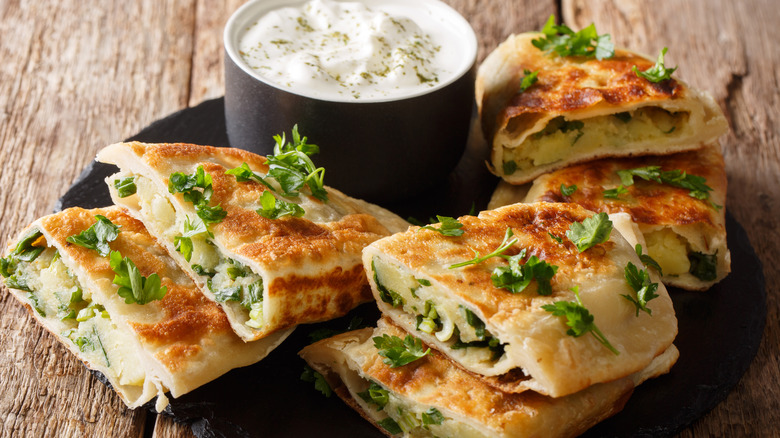How Afghan Street Food Bolani Is Traditionally Served
Most parts of the world have some version of a sandwich (perhaps a certain kissing cousin of sandwiches — the verdict is still out on quesadillas). Whatever side of the fence you are on, we can all appreciate handheld food that is portable, filling, and most often more affordable than an entire entree. And, when it comes to portability, the whole concept of street food is based on such.
Roam any street in Afghani cities such as Bamyan, and you'll likely follow your nose to a bazaar where local food vendors are plentiful. Included in the bounty of street foods is Afganistan's answer to the handheld: Bolani, which will set you back less than the equivalent of twenty cents in U.S currency. Pronounced buh·laa·nee, this street food is traditionally served vegetarian and shallow-fried to a golden crisp (somewhat resembling a quesadilla or crêpe). Whether you consider Bolani a sandwich, pancake, or something totally different, it is likely to become a staple of your go-to recipes. And, it is quite simple to make at home.
How to make Bolani
An Arabic flatbread, Bolani comes stuffed. Among some of its more traditional fillings are cilantro, gandana leaves, and the most filling ingredient — potatoes. If you're not familiar with gandana, it's a perennial leek grown in Afghanistan that tastes like scallions or garlic chives (if unavailable, other leek varieties will work as well). How you season the Bolani can range from salt and pepper to the inclusion of spices such as chilis and ground coriander.
For the dough, you will need flour, yeast, salt, and olive oil. The basic bolani recipe is similar to making homemade naan, except that the dough is flattened out as thin as possible. It is stuffed with a small amount of the filling and then folded over into a half-moon shape. Bolani is traditionally shallow-fried with a bit of oil. So, make sure to slide the Bolani into your frying pan one at a time once the oil is hot. Also, make sure to flip it. A golden crispy Bolani is what you want — not a soggy mess.
There are a couple of sauces usually served with Bolani. One, similar to raita, consists of yogurt, ground coriander, minced garlic, a squeeze of lemon juice, and salt. Sometimes, the yogurt-based sauce includes peppers and mint. Or, opt for a spicy vinegar-based cilantro chutney. The Bolani is then torn off into pieces, rolled up, and dipped into your sauce of choice. Finally, keep tradition with a hot tea pairing.

